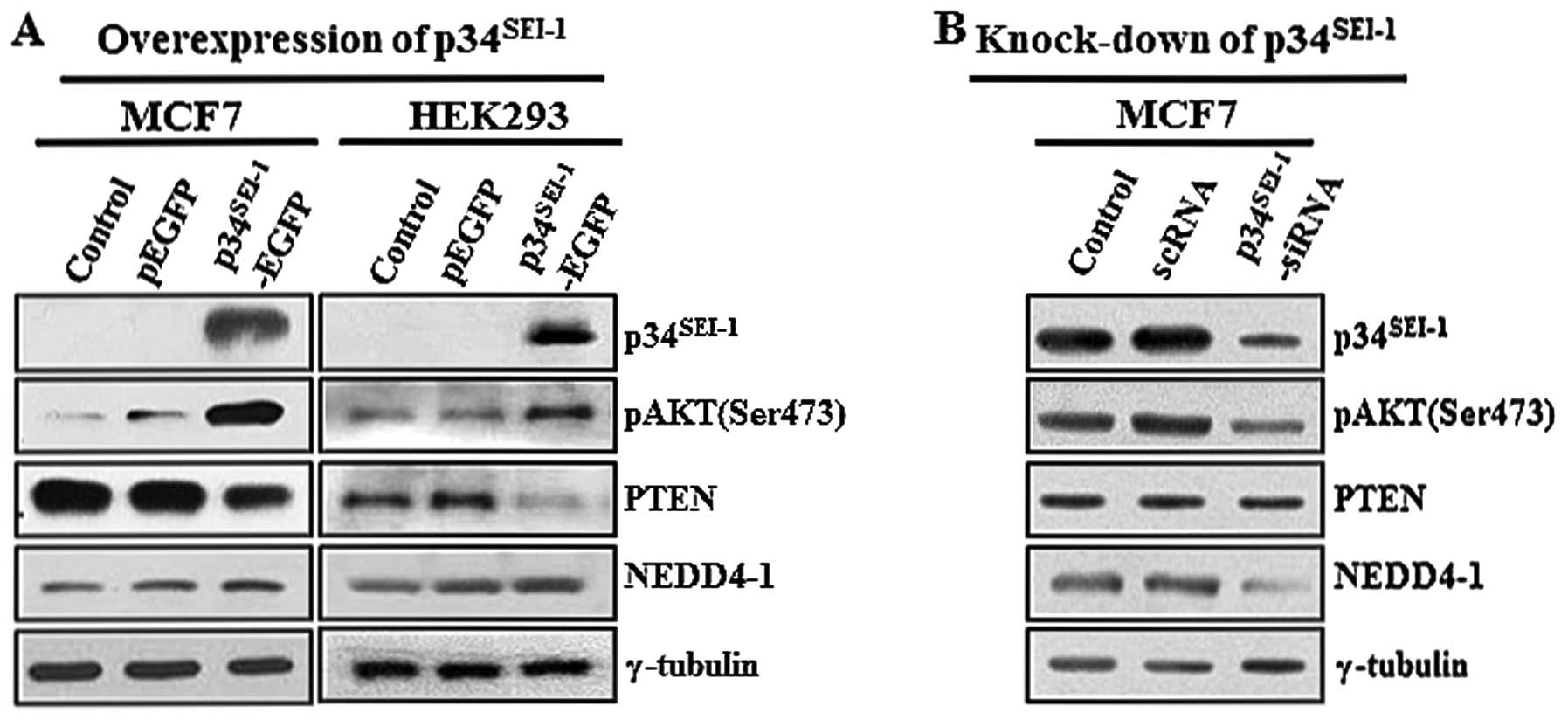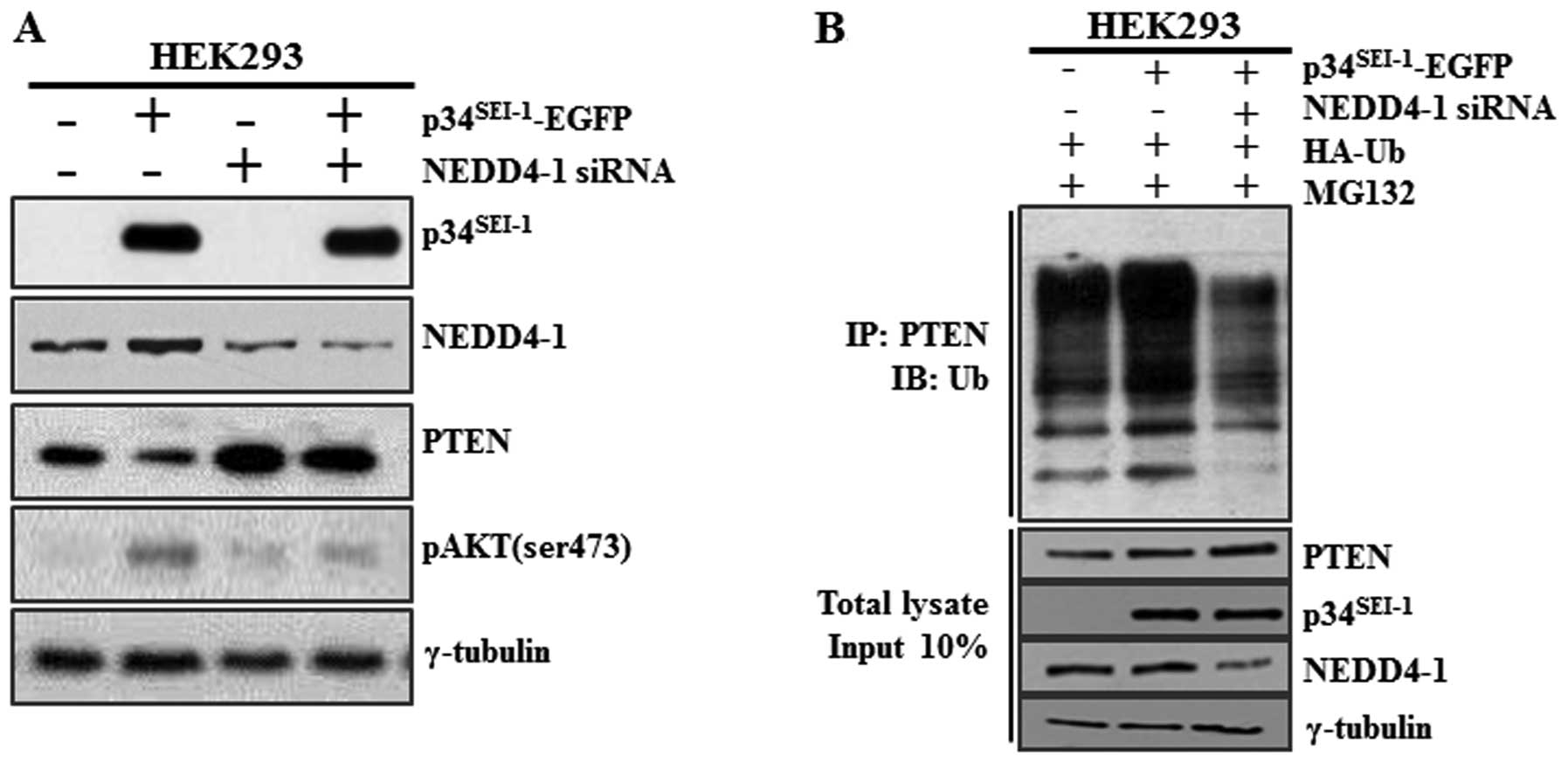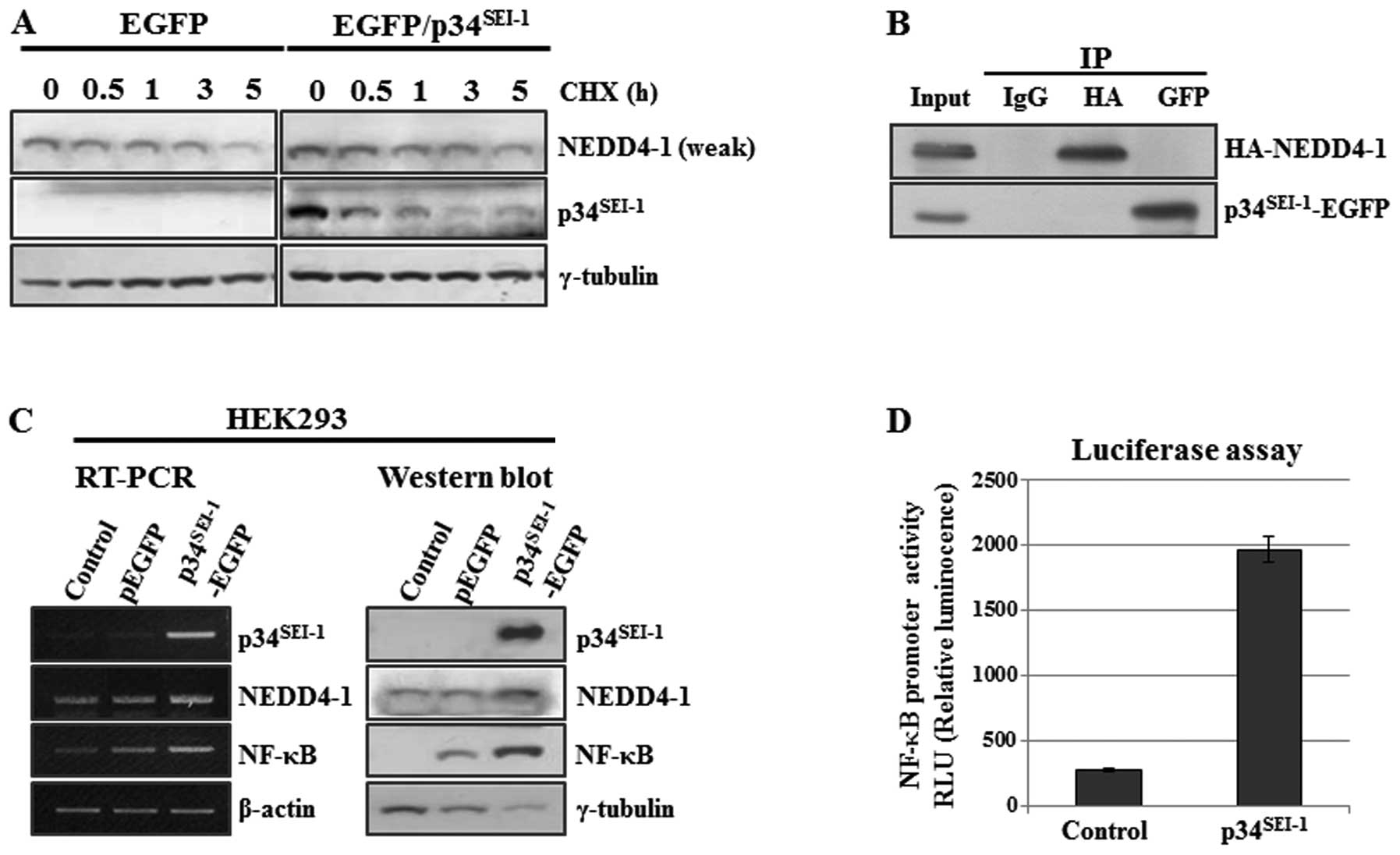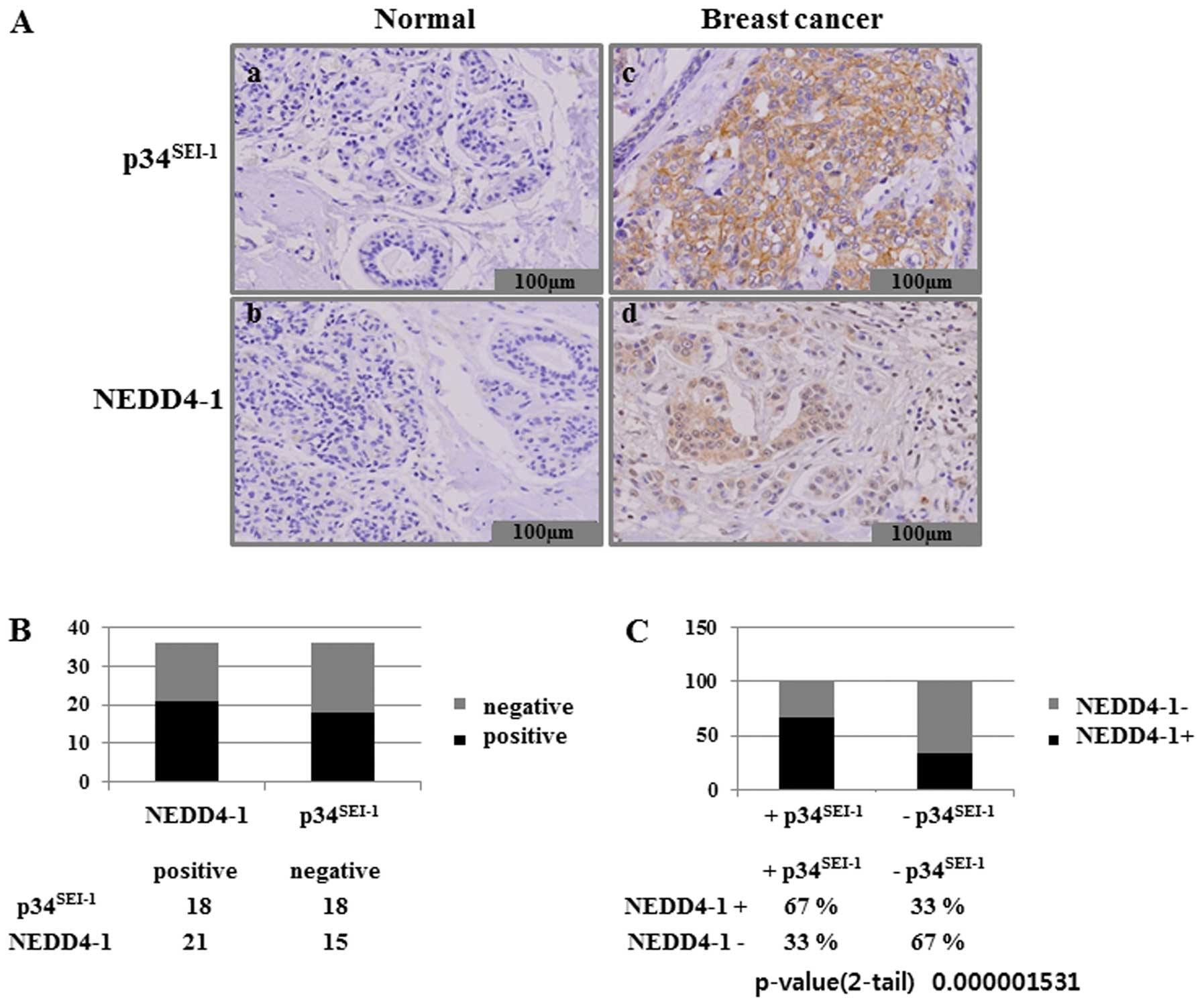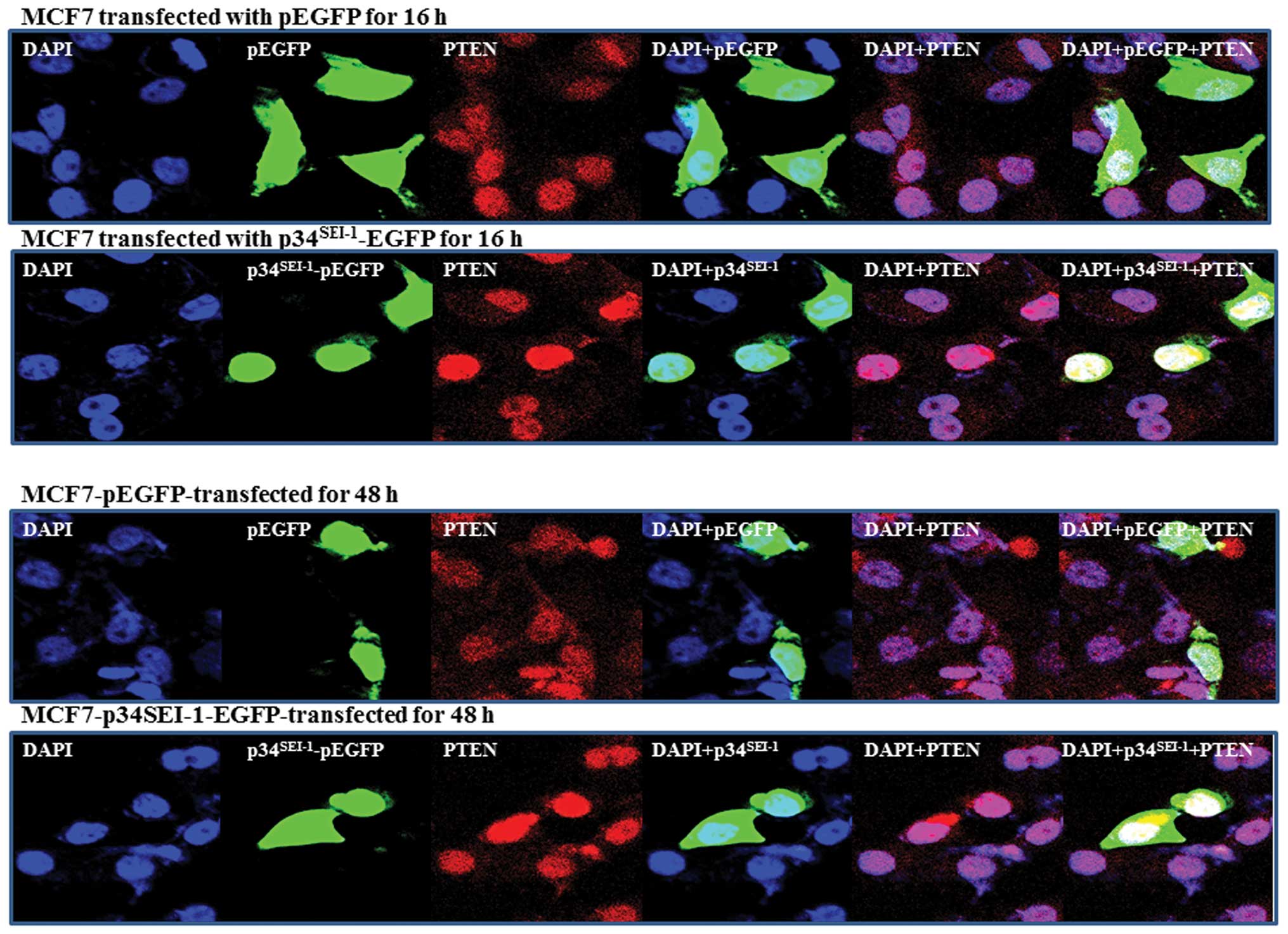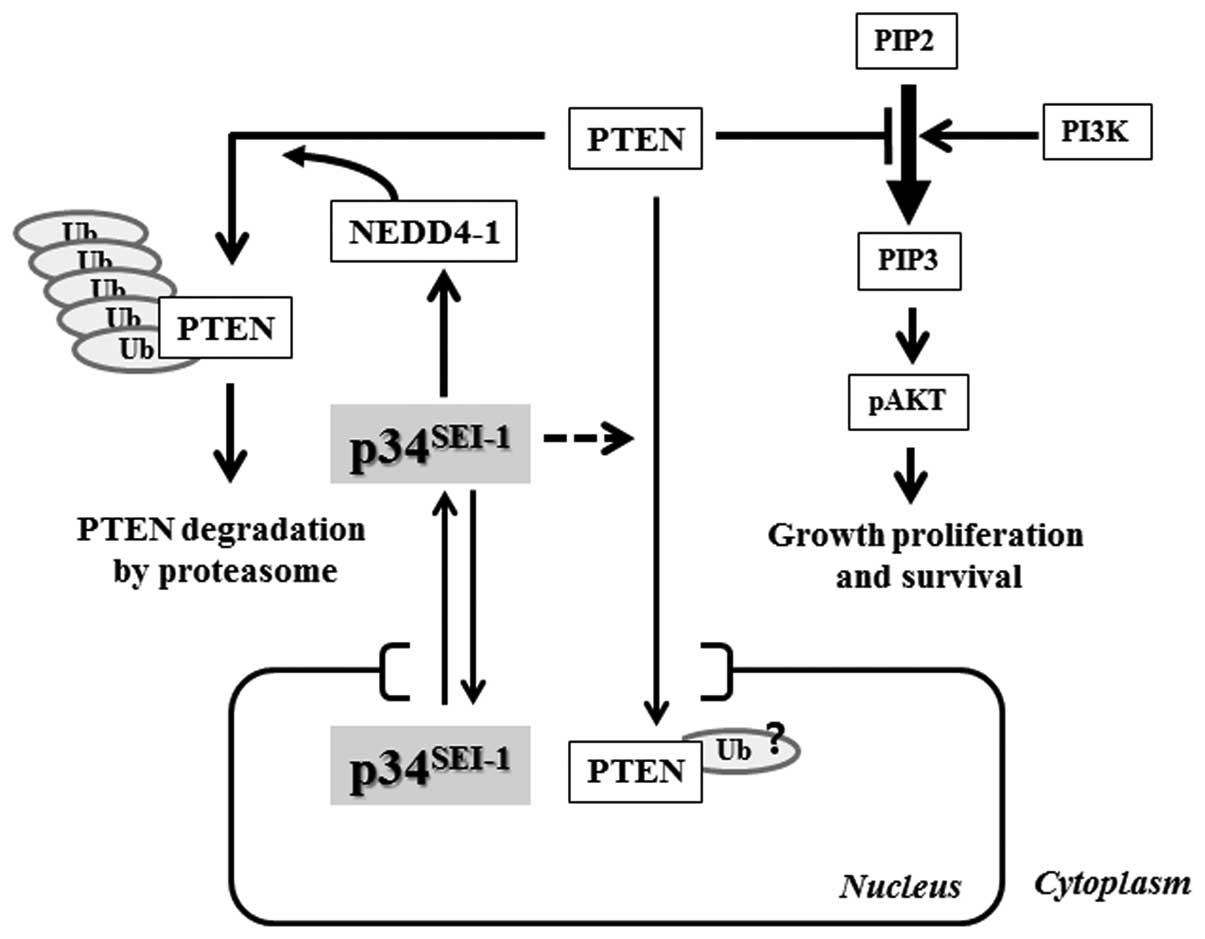Oncogenic function of p34SEI-1 via NEDD4‑1‑mediated PTEN ubiquitination/degradation and activation of the PI3K/AKT pathway
- Authors:
- Published online on: August 20, 2013 https://doi.org/10.3892/ijo.2013.2064
- Pages: 1587-1595
Abstract
Introduction
The PI3K/AKT signaling pathway regulates various cellular functions including tumorigenesis by inhibiting apoptosis and activating proliferation of cancer cells (1–5). Phosphoinositide 3-kinases (PI3Ks) are lipid kinases that phosphorylate phosphatidylinositol-4, 5-biphosphate (PIP2) to phosphatidylinositol-3, 4, 5-triphosphate (PIP3) (6). The resulting PIP3 phosphorylates and activates protein kinase B (AKT, also known as PKB) serine/threonine-specific protein kinase, which plays a key role in multiple cellular processes. Importantly, the activated AKT regulates many events related with tumor malignancies such as metastasis, apoptosis, proliferation, invasion, migration and motility (7–12). Notably, this pathway is often found to be overactive in cancer cells. Many researchers have accordingly tried to develop cancer drugs to inhibit this crucial signaling pathway at some point. The PI3K/AKT pathway is known to be negatively regulated by a well-known tumor suppressor phosphatase and tensin homologue (PTEN), in which PTEN dephosphorylates PIP3 to PIP2 preventing activation of AKT (13–15). The PI3K/AKT pathway can be hyper-activated in PTEN defective cells (16–18) and PTEN is frequently found to be mutated or deleted in various human cancers (16–21). Therefore, suppressing the PTEN function is an alternative way for cancer cells to obtain oncogenic activity. Neural precursor cell expressed, developmentally downregulated 4-1 (NEDD4-1) is an effective target in this regard. Wang et al suggested that NEDD4-1 degrades PTEN protein by catalyzing PTEN poly-ubiquitination (22). In fact, an inverse relationship between PTEN and NEDD4-1 expression levels is often found in human urinary lung cancer (23). Considering these findings, elimination of NEDD4-1 function seems to be an effective means of inhibiting tumorigenesis in a PTEN-dependent manner.
In an effort to identify the physiological mechanism that triggers the induction of NEDD4-1-mediated PTEN downregulation, we found the involvement of p34SEI-1 in this process. p34SEI-1 is known to act as a transcriptional regulator, cell cycle regulator, senescence inhibitor and apoptosis inhibitor (22,24–29). Especially, it plays a critical role in tumor pathogenesis acting as an oncoprotein. We previously showed that the expression level of p34SEI-1 significantly increased in breast cancer patients relative to healthy subjects (26). Several different research groups have suggested that p34SEI-1 exerts oncogenic effects by deregulating several vital pathways. For example, p34SEI-1 overexpression is associated with upregulation of E2F-mediated transcription, transformation of NIH3T3 fibroblasts, promotion of tumor growth in athymic nude mice, and chromosomal instability (22,24–29). Most importantly, our previous study showed the p34SEI-1 protein maximizes oncogenic characteristics by providing an anti-apoptotic function to cancer cells and increasing the survival of tumor cells (26). According to our data, the p34SEI-1 confers resistance to various apoptotic stimuli on human breast cancer cells by stabilizing XIAP (X-linked inhibitor of apoptosis protein) (26). In the process of elucidating the mechanism of p34SEI-1 mediated tumorigenesis, we suspected that p34SEI-1 might obtain its oncogenic potential in part through activation of the PI3K/AKT pathway. Therefore, we tested the involvement of p34SEI-1 in the regulation of the PI3K/AKT signaling pathway via NEDD4-1 mediated PTEN degradation.
In this report, we suggest that p34SEI-1 oncogenic protein promotes tumor progression by inducing NEDD4-1 mediated PTEN ubiquitination/degradation and activating the PI3K/AKT pathway.
Materials and methods
Cell lines and cell culture
MCF7 breast cancer and HEK293 human epithelial kidney cells were used for this study. Each cell line was cultured in DMEM medium (WelGENE Inc., Daegu, Korea) supplemented with 10% fetal bovine serum (Gibco-BRL, Carlsbad, CA, USA) and 1% antibiotic-antimycotic (Gibco-BRL). All of the cells were cultured at 37°C in a humidified atmosphere composed of 95% air and 5% CO2.
Western blot analysis
Cells were washed in an ice-cold PBS buffer and lased in RIPA lysis buffer (1% sodium deoxycholate, 0.1% SDS, 1% Triton X-100, 10 mM Tris-HCl, pH 8.0, 140 mM NaCl, 0.025% NaN3 and 1.0 mM protease inhibitor). The protein amount was quantified using a protein assay kit (Bio-Rad, Seoul, Korea). Each protein sample was subjected to SDS-PAGE and transferred to an Immobilon Transfer Membranes (Millipore, cat. no. IPVH00010, Billerica, MA, USA). The filter was blocked in 5% non-fat dry milk/0.1% Tween/TBS followed by incubation with each corresponding antibody. Immune-detection was done by using the Power Opti-ECL Western blotting Detection reagent (Bionote, Hwaseong, Korea). Antibodies used in this study were purchased as follows: p34SEI-1 (Enzo Life Sciences, ALX-804-645, Farmingdale, NY, USA), pAKT (Ser473) (Cell Signaling, cat. no. 9271, Danvers, MA, USA), PTEN (Santa Cruz Biotechnology, sc-7974, Santa Cruz, CA, USA), NEDD4-1 (Santa Cruz Biotechnology, sc-25508), and γ-tubulin (Santa Cruz Biotechnology, sc-7396).
Overexpression and knockdown of p34SEI-1 and NEDD4-1
For ectopic overexpression of p34SEI-1, MCF7 or HEK293 cells were transfected for 12, 24 or 48 h with 6-8 μg of either C-terminal EGFP-tagged p34SEI-1 expression vector (p34SEI-1-EGFP) or a control vector (pEGFP) by using Lipofectamine 2000 (Invitrogen, Seoul, Korea). To knockdown endogenous p34SEI-1 and NEDD4-1, MCF7 or HEK293 cells were transiently transfected with p34SEI-1 or NEDD4-1 specific siRNA (20 pmol siRNA final concentration) with a control of scrambled siRNA. The following target sequences were used to generate p34SEI-1 or NEDD4-1 siRNA; p34SEI-1 siRNA (5-CCGAAUUGGACUAC CUCAUdTdT-3) and NEDD4-1 siRNA (5-UUCCAUGAAUC UAGAAGAACATT-3 (30). p34SEI-1 siRNA was obtained from Santa Cruz Biotechnology (sc-62988) and NEDD4-1 oligonucleotides were chemically synthesized by ST Pharm Co. Ltd (Seoul, Korea).
Immunoprecipitation
To analyze the interaction between p34SEI-1 and NEDD4-1, HEK293 cells were co-transfected with EGFP-tagged p34SEI-1 (p34SEI-1-EGFP) and HA-tagged NEDD4-1 (pHA-NEDD4-1) plasmids and cell lysates were immuno precipitated with either anti-EGFP (Abcam, ab290, Cambridge, MA, USA) or anti-HA (Sigma, H9658, St. Louis, MO, USA) antibodies. IP was performed by lysing cells in IP buffer (50 mM of Tris-HCl pH 7.4, 150 mM of NaCl, 10 mM of NaF, 10 mM of Na3VO4, 1 mM of PMSF, 1% of NP-40) with protease inhibitors, followed by pre-clearing with protein A/G Sepharose (Santa Cruz Biotechnology, sc-2003). Pre-cleared lysates were incubated with each antibody for 16 h at 4°C with continuous agitation, and then protein A/G Sepharose was added. After 4 h, the lysate-antibody-agarose A/G bead complex was collected by centrifugation at 10,000 x g for 5 min, the complex was then washed three times with IP buffer, and proteins were eluted from the beads by boiling them in SDS sample buffer and analyzed by using a western blot with the indicated a ntibodies. Proteins were probed with the corresponding antibodies.
In vivo PTEN-ubiquitination assay
HEK293 cells were transfected with p34SEI-1-EGFP plasmid and/or NEDD4-1 siRNA in the presence of HA-Ub. Forty-eight hours after transfection, cells were treated with 10 μM proteasome inhibitor MG132 (A.G. Scientific Inc, M-1157, San Diego, CA, USA) for 16 h. The cells were lysed with RIPA buffer with protease inhibitors. The lysates were centrifuged to obtain cytosolic proteins. Ubiquitinated PTEN was immunoprecipitated by anti-PTEN antibody (Santa Cruz Biotechnology, sc-7974), followed by immunoblotting with anti-Ub antibody (Santa Cruz Biotechnology, sc-8017).
Immunohistochemistry analysis
Four-micrometer-thick sections were sliced onto Silane Coated Micro Slides (Muto Pure Chemicals Corp., Tokyo, Japan) and incubated at 60°C for 2 h. The slides were then deparaffinised by application of xylene and incubation (5 min x 3) at room temperature. Sections were hydrated by applying graded alcohol and endogenous peroxidase activity was quenched by incubating the sections in methanol with 0.3% H2O2 for 30 min at room temperature. After washing the slides in PBS (5 min x 2), antigen retrieval was performed by heating the slides in citrate buffer (0.01 M, pH 6.0) using a microwave in a pressure cooker for 15 min. After heating, the samples were allowed to cool for 2 h at room temperature followed by washing with PBS (5 min x 2). An immunohistochemical analysis was performed using p34SEI-1 (Biorbyt, Cambridge, UK) and NEDD4-1 (Proteintech, cat. no. 13690-1-AP, Chicago, IL, USA) rabbit polyclonal antibodies with 1:50 dilution each by PBS. The tissues were incubated with primary antibodies for 2 h at room temperature and washed three times with PBS followed by incubation using an Ultra Vision Quanto Detection System HRP DAB (Lab Vision Corp., Fremont, CA, USA) according to the manufacturer’s instructions. The immunostained slides were examined by two independent observers and a consensus score was determined for each specimen. A positive reaction for both antibodies was scored into 4 grades, according to the intensity of the staining: 0, 1+, 2+ and 3+. The percentages of positive cells were also scored into 4 categories: 0, 0%; 1, 1–30%; 2, 31–60%; and 3, 61–100%. The final score, calculated as the product of the intensity score multiplied by the percentage score, was classified as follows: 0, negative; 1–3, weak; 4–6, moderate; and 7–9, strong. Samples with a final score less than 3 were grouped together as expression negative while those with a score greater than 4 were grouped together as expression positive.
Reverse transcription (RT)-PCR
The total RNA was extracted from HEK293 cells after transfection with either pEGFP or p34SEI-1-EGFP using an RNeasy mini kit (Qiagen, Hilden, Germany). For reverse transcription, 1 μg RNA of each sample was subjected to cDNA synthesis using an oligo (dT) primer and the ImProm-II™ Reverse Transcription System (Promega, A3800, Madison, WI, USA) following the manufacturer’s instructions. Each gene product was amplified using 10 ng cDNA, the corresponding pair of primers, and an AccuPower PCR PreMix system (Bioneer, Daejeon, Korea), in which the β-actin gene product was used as an internal control (Table I).
Reporter assay
Cells were co-transfected with p34SEI-1-EGFP and pGL4-NF-κB plasmids using Lipofectamine 2000 (Invitrogen) transfection reagent following the manufacturer’s protocol, in which the NF-κB genes were subcloned into the pGL4 basic luciferase reporter vector (pGL4.1; Promega). The following day, 14–18 h later, cells were lysed and luciferase assays were performed using Luciferase Assay System (Promega, cat. no. E1501) and the luciferase activity levels were measured after standardization against pGL4.1.
Results
Effect of p34SEI-1on the alteration of pAKT, PTEN, and NEDD4-1 protein levels
As part of an effort to identify how p34SEI-1 promotes tumor progression in various cancer cells, we initially tested the effect of p34SEI-1 on the PI3K/AKT signaling pathway because of its vital roles in tumorigenesis. After MCF7 and HEK293 cells were transfected with the EGFP control vector (pEGFP) and C-terminal EGFP-tagged p34SEI-1 (p34SEI-1-EGFP) plasmids, AKT phosphorylation on serine 473 residue was examined because phosphorylation on this residue is known to promote signal transduction related with tumor malignancies. Our data showed that p34SEI-1 overexpression significantly increased AKT phosphorylation on this residue (Fig. 1A). In contrast, the AKT phosphorylation level was decreased when MCF7 cells were treated with p34SEI-1-siRNA compared to scrambled siRNA-treated control cells (Fig. 1B). This strongly suggests that p34SEI-1 has a positive effect on AKT phosphorylation and therefore activation of the PI3K/AKT signaling pathway. Next, we tested the alteration of PTEN and NEDD4-1 expression levels in response to ectopic expressed p34SEI-1 because they are the main components affecting the PI3K/AKT signaling pathway. Interestingly, the western blot analysis revealed that p34SEI-1 overexpression slightly decreased PTEN but increased NEDD4-1 at the protein levels (Fig. 1A). We then tested PTEN and NEDD4-1 protein levels in MCF7 cells transfected with p34SEI-1-siRNA. As expected, NEDD4-1 expression significantly decreased relative to the scrambled siRNA-treated cells. However, no change in the PTEN protein level was detected, likely due to a weak or even no effect of NEDD4-1 on downregulation of PTEN (Fig. 1B). Taken together, our results implicate that p34SEI-1 activates the PI3K/AKT signaling pathway at least in part by regulating NEDD4-1 and PTEN.
p34SEI-1 induced ubiquitination and degradation of PTEN in a NEDD4-1 dependent way
Our results imply that p34SEI-1 may downregulate PTEN in a NEDD4-1-dependent manner. However, it is possible that p34SEI-1 may affect other proteins or pathways and indirectly cause PTEN downregulation. For example, p34SEI-1 might activate different types of E3 ligases rather than NEDD4-1 and downregulate PTEN. In fact, two different research groups suggested apparently discrepant results. Wang et al suggested that NEDD4-1 directly binds to PTEN and induces its ubiquitination and degradation (31). However, Fouladkou et al showed a contradictory result that NEDD4-1 is dispensable for the regulation of PTEN stability (23,32). To test whether PTEN downregulation by p34SEI-1 is NEDD4-1 dependent, the PTEN protein level was checked after HEK293 cells were transfected with p34SEI-1-EGFP vector and/or NEDD4-1 siRNA (Fig. 2A). Our result showed that siRNA-induced NEDD4-1 silencing induced an increase of endogenous PTEN protein level and a concurrent decrease of AKT phosphorylation. Importantly, p34SEI-1 overexpression alone reduced the PTEN protein level but co-transfection of p34SEI-1-EGFP and NEDD4-1 siRNA had no effect on the PTEN protein level (Fig. 2A). This finding suggests that p34SEI-1 decreases the PTEN protein level in a NEDD4-1 E3 ligase-dependent manner. The data strongly imply that p34SEI-1 is responsible for the PTEN ubiquitination and its subsequent degradation. Therefore, a ubiquitination assay was performed to determine whether downregulation of PTEN stimulated by p34SEI-1 is derived from ubiquitination-mediated protein degradation. HEK293 cells were transfected with p34SEI-1-EGFP vector and/or NEDD4-1 siRNA in the presence of HA-Ub and MG132. The resulting cells were subjected to immunoprecipitation (IP) and immunoblot (IB) analyses as mentioned in Materials and methods. As shown in Fig. 2B, endogenous PTEN was significantly ubiquitinated in p34SEI-1 overexpressing cells compared to control cells. However, this did not occur in cells co-transfected with p34SEI-1-EGFP and NEDD4-1 siRNA indicating that NEDD4-1 is required for p34SEI-1-mediated PTEN ubiquitination. Taken together, these results strongly suggest that p34SEI-1 induces PTEN ubiquitination in a NEDD4-1 dependent manner and thereby targets PTEN for proteasomal degradation.
Positive effect of p34SEI-1 on NEDD4-1 expression both at the transcriptional and protein levels
Our data indicate that p34SEI-1 might exert positive effect on NEDD4-1 expression probably by controlling NEDD4-1 turnover. This hypothesis was examined by employing cycloheximide chase experiment. Briefly, HEK293 cells were transfected with pEGFP and p34SEI-1-EGFP plasmids in the presence of cycloheximide (CHX, 20 μg/ml), an inhibitor of protein biosynthesis and NEDD4-1 protein levels were checked at the indicated times of treatment as shown in Fig. 3A. NEDD4-1 expression slowly decreased in p34SEI-1-EGFP transfected cells compared to the control cells (Fig. 3A). This strongly suggests that p34SEI-1 stabilizes NEDD4-1 by preventing proteasome-dependent protein degradation. The next question was how p34SEI-1 can stabilize NEDD4-1 protein. One possibility is that p34SEI-1 may stabilize NEDD4-1 via direct interaction with it. To test this hypothesis, HEK293 cells were co-transfected with p34SEI-1 and NEDD4-1 overexpressing vectors (p34SEI-1-EGFP and HA-NEDD4-1) and cell lysates were used for co-immunoprecipitation using anti-EGFP (i.e., p34SEI-1-EGFP) or anti-HA (i.e., HA-NEDD4-1) antibodies. However, no direct interaction was detected between p34SEI-1 and NEDD4-1 protein (Fig. 3B). Moreover, we also found the same result from an examination of molecular interactions between endogenous p34SEI-1 and NEDD4-1 (data not shown).
In addition, the positive effect of p34SEI-1 on NEDD4-1 expression was also checked at the transcriptional level because p34SEI-1 is a well-known transcriptional co-activator. NEDD4-1 transcription was measured by using RT-PCR after HEK293 cells were transfected with either pEGFP or p34SEI-1-EGFP expression vector. Our data showed that NEDD4-1 transcription was slightly increased by p34SEI-1 overexpression (Fig. 3C). However, our luciferase assay showed no direct effect of p34SEI-1 on NEDD4-1 transcription (data not shown). Considering that p34SEI-1 is a transcriptional co-activator, we could not exclude the other possibility that p34SEI-1 might indirectly activate NEDD4-1 transcription by working with other transcriptional activator. To test this hypothesis, we first searched transcription factor binding sites in the NEDD4-1 gene promoter by using the TRANSFAC database (http://www.genome.ad.jp). Many putative transcription factor binding sites were found in the NEDD4-1 gene promoter, including NF-κB, FOXO3b, FOXO3a, FOXD1, FOXO1a, FOXO4 and Nkx2-2. Among them, we initially focused on NF-κB because the PI3K/AKT signaling pathway is known to be strongly related with NF-κB activity (16,33,34). More importantly, Judge et al suggested that NEDD4 is one of the targets of NF-κB transcription factor (35). As shown in Fig. 3C, NF-κB expression was slightly or significantly increased by p34SEI-1 overexpression both at the transcriptional and protein levels, respectively. In a further study, a luciferase assay was employed to examine the direct effect of p34SEI-1 on the NF-κB transcriptional activation. The luciferase assay was performed by transfecting pGL4-NF-κB and p34SEI-1-EGFP into HEK293. As shown in Fig. 3D, over-expressed p34SEI-1 significantly activated NF-κB transcription. Our data suggest that p34SEI-1 seems to indirectly activate NEDD4-1 transcription through NF-κB transcription factor. We showed that p34SEI-1 overexpression significantly increased NF-κB transcription. Our further search of transcription factor binding sites in the NF-κB gene promoter revealed the putative binding site of p300, a known p34SEI-1 interacting protein. Therefore, it is possible that p34SEI-1 may enhance transcriptional activation of NF-κB via the interaction with p300. However, this needs to be tested further. Considering all these data, we conclude that p34SEI-1 exerts a positive effect on NEDD4-1 stability but not through direct interaction with NEDD4-1, whereby p34SEI-1 positively affects NEDD4-1 both at the transcriptional and protein levels.
Correlation between p34SEI-1 and NEDD4-1 expression levels in breast tissues containing adjacent histologically normal and invasive ductal carcinoma tissues
Considering the role of p34SEI-1 as a positive regulator of NEDD4-1, we hypothesized that high level of p34SEI-1 in cancer cells might contribute to similar high levels of NEDD4-1 protein in cancer cells. We therefore conducted an immunohistochemical analysis of both p34SEI-1 and NEDD4-1 expression in 36 tissue samples from patients with breast cancer. We assessed p34SEI-1 expression in formalin-fixed and paraffin-embedded samples obtained from surgical resections of 36 patients with breast cancer. Normal and cancer breast tissues showed immune-negative and strong immune-positive staining, respectively, for both p34SEI-1 and NEDD4-1 (Fig. 4A). This suggests that expression levels of p34SEI-1 and NEDD4-1 are very low in normal breast tissue but strong in breast cancer cells. The immunohistochemical analysis also revealed that significant overexpression of p34SEI-1 and NEDD4-1 was detected in 18 (50%) of the 36 and in 21 (58%) of the 36 breast cancer tissue samples, respectively (Fig. 4B). Interestingly, NEDD4-1 levels were found to be consistently higher in the areas of high p34SEI-1 protein level. Our examination of the co-expression of p34SEI-1 and NEDD4-1 in breast cancer cells showed that NEDD4-1 was expressed in 67% of the p34SEI-1 positive samples (Fig. 4C). These data confirm that p34SEI-1 has a positive effect on the NEDD4-1 expression in cancer cells. This is consistent with the findings that both p34SEI-1 and NEDD4-1 have oncogenic potential and their expression levels are increased as tumor invasiveness progresses. Taken together, our data strongly suggest that p34SEI-1 and NEDD4-1 are significantly over-expressed in breast cancer tissues.
PTEN subcellular localization in response to p34SEI-1
It has been suggested that PTEN is located in the nucleus as well as the cytosol. Trotman et al suggested that PTEN localization is affected by NEDD4-1, which can both mono- and poly-ubiquitinate (31). PTEN nuclear localization is mediated by its mono-ubiquitination. We thus far have shown that p34SEI-1 induces NEDD4-1-mediated PTEN poly-ubiquitination. Considering p34 has an oncogenic potential working with NEDD4-1 E3 ligase, it was expected that p34SEI-1 might affect PTEN nuclear localization. To test this hypothesis, we analyzed PTEN nuclear localization in response to p34SEI-1 by using immunofluorescence, as mentioned in Materials and methods. In normal conditions, endogenous PTEN is found both in the nucleus and cytoplasm of MCF7 cells. However, when p34SEI-1 is overexpressed as EGFP fusion, our IF data revealed a different distribution of PTEN in nucleus in p34SEI-1 overexpressing and control cells. PTEN accumulated much more inside the nucleus after transfection within 16 h and lasted until 48 h (Fig. 5). In contrast, the PTEN protein level was slightly reduced in cytosolic accumulation compared to non-transfected cells (Fig. 5). This suggests that p34SEI-1 positively affects PTEN nuclear import. Taken together, the results indicate that p34SEI-1 affects subcellular localization of PTEN, in which p34SEI-1 overexpression induces PTEN nuclear localization.
Discussion
The PI3K signaling pathway plays important roles in cells by controlling many different cellular functions, in which AKT is the key regulator of the PI3K pathway to promote signal transduction related with tumor malignancies. AKT is phosphorylated and activated by either PI3K activation or PTEN inactivation. In the present study, we suggest a mechanism of how p34SEI-1 has oncogenic potential to promote carcinogenesis. Our data show that p34SEI-1 overexpression stabilizes NEDD4-1 and in turn NEDD4-1 induces poly-ubiquitination/degradation of a PTEN tumor suppressor, and subsequently promotes tumorigenesis by positively regulating the PI3K/AKT pathway as summarized in Fig. 6.
We previously showed that p34SEI-1 directly binds and stabilizes the X-linked inhibitor of apoptosis protein (XIAP) leading to an anti-apoptotic effect (26). Interestingly, the group of Van Themsche (36) suggested that XIAP can act as an E3 ligase for PTEN and therefore directly induces PTEN ubiquitination. Considering all these results, it is likely that p34SEI-1 may have an indirect effect on PTEN ubiquitination/degradation through XIAP. Thus, we also tested the effect of p34SEI-1 on XIAP mediated PTEN ubiquitination/degradation. However, our data revealed XIAP-independent PTEN ubiquitination/degradation (data not shown). Similarly, it needs to be considered that p34SEI-1 may affect different types of PTEN ubiquitin ligases that are responsible for PTEN ubiquitination/degradation.
Our data revealed that p34SEI-1 affects PTEN subcellular localization as well as its protein expression. It has been suggested that NEDD4-1 can mediate both mono- and poly-ubiquitination of PTEN and it can cause PTEN nuclear transport by catalyzing PTEN mono-ubiquitination (31). Considering the positive effect of p34SEI-1 on NEDD4-1 expression, it is suspected that p34SEI-1 may induce mono-ubiquitination as well as poly-ubiquitination of PTEN. Therefore, p34SEI-1 seems to positively control nuclear import of PTEN by upregulating NEDD4-1 expression as shown in Fig. 5. However, our immunofluorescence data were unexpected in the PTEN’s subcellular distribution in response to p34SEI-1 overexpression. The reason is that PTEN nuclear localization has been suggested to be essential to suppress tumorigenesis and is mediated by its mono-ubiquitination (31). Considering that p34SEI-1 is an oncoprotein, which normally activate tumorigenesis, it was expected that p34SEI-1 over expression would inhibit PTEN nuclear import. We thought that p34SEI-1 might exert a negative effect on PTEN in the nucleus as in the case of cytosol, even though p34SEI-1 induced PTEN nuclear import. However, the mechanism by which p34SEI-1 exerts a positive effect on PTEN nuclear localization remains unclear. Further research is needed to determine the effects of p34SEI-1 on PTEN nuclear localization.
In summary, our previous and current results suggest that p34SEI-1 is highly expressed in human breast cancer cells acting as an oncoprotein. In this process, p34SEI-1 appears to cause tumorigenesis by inducing NEDD4-1-mediated PTEN down-regulation and positively regulating the PI3K/AKT pathway. Thus, therapeutic strategies that interfere with the function of p34SEI-1 are expected to be promising targets for new anticancer drugs for breast cancer treatment.
Abbreviations:
|
p34SEI-1 |
34-KD protein encoding SEI-1 (selected with Ink4a-1 as bait) gene; |
|
PTEN |
phosphatase and tensin homolog deleted on chromosome ten; |
|
NEDD4-1 |
neuronal precursor cell-expressed developmentally downregulated 4-1; |
|
PI3K |
phosphoinositide-3 kinase |
Acknowledgements
This study was supported by the National Research Foundation of Korea (NRF) grant funded by the Korean government (MEST) (nos. R11-2005-017-04001-0 and 2011-0030701) and Basic Science Research Program through the National Research Foundation of Korea (NRF) funded by the Ministry of Education, Science and Technology (2012R1A1A3012438).
References
|
Morgensztern D and McLeod HL: PI3K/Akt/mTOR pathway as a target for cancer therapy. Anticancer Drugs. 16:797–803. 2005. View Article : Google Scholar : PubMed/NCBI | |
|
Cortot A, Armand JP and Soria JC: PI3K-AKT-mTOR pathway inhibitors. Bull Cancer. 93:19–26. 2006.(In French). | |
|
Yap TA, Garrett MD, Walton MI, Raynaud F, de Bono JS and Workman P: Targeting the PI3K-AKT-mTOR pathway: progress, pitfalls, and promises. Curr Opin Pharmacol. 8:393–412. 2008. View Article : Google Scholar : PubMed/NCBI | |
|
LoPiccolo J, Blumenthal GM, Bernstein WB and Dennis PA: Targeting the PI3K/Akt/mTOR pathway: effective combinations and clinical considerations. Drug Resist Updat. 11:32–50. 2008. View Article : Google Scholar : PubMed/NCBI | |
|
Yuan TL and Cantley LC: PI3K pathway alterations in cancer: variations on a theme. Oncogene. 27:5497–5510. 2008. View Article : Google Scholar : PubMed/NCBI | |
|
Kong D and Yamori T: Advances in development of phosphatidylinositol 3-kinase inhibitors. Curr Med Chem. 16:2839–2854. 2009. View Article : Google Scholar : PubMed/NCBI | |
|
Qiao M, Sheng S and Pardee AB: Metastasis and AKT activation. Cell Cycle. 7:2991–2996. 2008. View Article : Google Scholar | |
|
Xue G, Restuccia DF, Lan Q, et al: Akt/PKB-mediated phosphorylation of Twist1 promotes tumor metastasis via mediating cross-talk between PI3K/Akt and TGF-beta signaling axes. Cancer Discov. 2:248–259. 2012. View Article : Google Scholar : PubMed/NCBI | |
|
Brader S and Eccles SA: Phosphoinositide 3-kinase signalling pathways in tumor progression, invasion and angiogenesis. Tumori. 90:2–8. 2004.PubMed/NCBI | |
|
Grille SJ, Bellacosa A, Upson J, et al: The protein kinase Akt induces epithelial mesenchymal transition and promotes enhanced motility and invasiveness of squamous cell carcinoma lines. Cancer Res. 63:2172–2178. 2003.PubMed/NCBI | |
|
Toker A and Yoeli-Lerner M: Akt signaling and cancer: surviving but not moving on. Cancer Res. 66:3963–3966. 2006. View Article : Google Scholar : PubMed/NCBI | |
|
Yoeli-Lerner M and Toker A: Akt/PKB signaling in cancer: a function in cell motility and invasion. Cell Cycle. 5:603–605. 2006. View Article : Google Scholar : PubMed/NCBI | |
|
Gagnon V, St-Germain ME, Parent S and Asselin E: Akt activity in endometrial cancer cells: regulation of cell survival through cIAP-1. Int J Oncol. 23:803–810. 2003.PubMed/NCBI | |
|
Maehama T and Dixon JE: The tumor suppressor, PTEN/MMAC1, dephosphorylates the lipid second messenger, phosphatidylinositol 3,4,5-trisphosphate. J Biol Chem. 273:13375–13378. 1998. View Article : Google Scholar : PubMed/NCBI | |
|
Stambolic V, Suzuki A, de la Pompa JL, et al: Negative regulation of PKB/Akt-dependent cell survival by the tumor suppressor PTEN. Cell. 95:29–39. 1998. View Article : Google Scholar : PubMed/NCBI | |
|
Akca H, Demiray A, Tokgun O and Yokota J: Invasiveness and anchorage independent growth ability augmented by PTEN inactivation through the PI3K/AKT/NFκB pathway in lung cancer cells. Lung Cancer. 73:302–309. 2011.PubMed/NCBI | |
|
Carver BS, Chapinski C, Wongvipat J, et al: Reciprocal feedback regulation of PI3K and androgen receptor signaling in PTEN-deficient prostate cancer. Cancer Cell. 19:575–586. 2011. View Article : Google Scholar : PubMed/NCBI | |
|
Taylor CJ, Qiao J, Colon NC, Schlegel C, Josifi E and Chung DH: Integrin-linked kinase regulates phosphatase and tensin homologue activity to promote tumorigenesis in neuroblastoma cells. Surgery. 150:162–168. 2011. View Article : Google Scholar : PubMed/NCBI | |
|
Tian XX, Pang JC, To SS and Ng HK: Restoration of wild-type PTEN expression leads to apoptosis, induces differentiation, and reduces telomerase activity in human glioma cells. J Neuropathol Exp Neurol. 58:472–479. 1999. View Article : Google Scholar : PubMed/NCBI | |
|
McMenamin ME, Soung P, Perera S, Kaplan I, Loda M and Sellers WR: Loss of PTEN expression in paraffin-embedded primary prostate cancer correlates with high Gleason score and advanced stage. Cancer Res. 59:4291–4296. 1999.PubMed/NCBI | |
|
Chang JG, Chen YJ, Perng LI, et al: Mutation analysis of the PTEN/MMAC1 gene in cancers of the digestive tract. Eur J Cancer. 35:647–651. 1999. View Article : Google Scholar : PubMed/NCBI | |
|
Wang X, Trotman LC, Koppie T, et al: NEDD4-1 is a protooncogenic ubiquitin ligase for PTEN. Cell. 128:129–139. 2007. View Article : Google Scholar : PubMed/NCBI | |
|
Amodio N, Scrima M, Palaia L, et al: Oncogenic role of the E3 ubiquitin ligase NEDD4-1, a PTEN negative regulator, in non-small-cell lung carcinomas. Am J Pathol. 177:2622–2634. 2010. View Article : Google Scholar : PubMed/NCBI | |
|
Hayashi R, Goto Y, Ikeda R, Yokoyama KK and Yoshida K: CDCA4 is an E2F transcription factor family-induced nuclear factor that regulates E2F-dependent transcriptional activation and cell proliferation. J Biol Chem. 281:35633–35648. 2006. View Article : Google Scholar | |
|
Hsu SI, Yang CM, Sim KG, Hentschel DM, O’Leary E and Bonventre JV: TRIP-Br: a novel family of PHD zinc finger-and bromodomain-interacting proteins that regulate the transcriptional activity of E2F-1/DP-1. EMBO J. 20:2273–2285. 2001. View Article : Google Scholar : PubMed/NCBI | |
|
Hong SW, Kim CJ, Park WS, et al: p34SEI-1 inhibits apoptosis through the stabilization of the X-linked inhibitor of apoptosis protein: p34SEI-1 as a novel target for anti-breast cancer strategies. Cancer Res. 69:741–746. 2009. View Article : Google Scholar : PubMed/NCBI | |
|
Li Y, Nie CJ, Hu L, et al: Characterization of a novel mechanism of genomic instability involving the SEI1/SET/NM23H1 pathway in esophageal cancers. Cancer Res. 70:5695–5705. 2010. View Article : Google Scholar : PubMed/NCBI | |
|
Tang DJ, Hu L, Xie D, et al: Oncogenic transformation by SEI-1 is associated with chromosomal instability. Cancer Res. 65:6504–6508. 2005. View Article : Google Scholar : PubMed/NCBI | |
|
Lee SL, Hong SW, Shin JS, et al: p34SEI-1 inhibits doxorubicin-induced senescence through a pathway mediated by protein kinase C-delta and c-Jun-NH2-kinase 1 activation in human breast cancer MCF7 cells. Mol Cancer Res. 7:1845–1853. 2009. View Article : Google Scholar : PubMed/NCBI | |
|
Lin Q, Wang J, Childress C, Sudol M, Carey DJ and Yang W: HECT E3 ubiquitin ligase Nedd4-1 ubiquitinates ACK and regulates epidermal growth factor (EGF)-induced degradation of EGF receptor and ACK. Mol Cell Biol. 30:1541–1554. 2010. View Article : Google Scholar : PubMed/NCBI | |
|
Trotman LC, Wang X, Alimonti A, et al: Ubiquitination regulates PTEN nuclear import and tumor suppression. Cell. 128:141–156. 2007. View Article : Google Scholar : PubMed/NCBI | |
|
Fouladkou F, Landry T, Kawabe H, et al: The ubiquitin ligase Nedd4-1 is dispensable for the regulation of PTEN stability and localization. Proc Natl Acad Sci USA. 105:8585–8590. 2008. View Article : Google Scholar : PubMed/NCBI | |
|
Burow ME, Weldon CB, Melnik LI, et al: PI3-K/AKT regulation of NF-kappaB signaling events in suppression of TNF-induced apoptosis. Biochem Biophys Res Commun. 271:342–345. 2000. View Article : Google Scholar : PubMed/NCBI | |
|
Holmes KM, Annala M, Chua CY, et al: Insulin-like growth factor-binding protein 2-driven glioma progression is prevented by blocking a clinically significant integrin, integrin-linked kinase, and NF-kappaB network. Proc Natl Acad Sci USA. 109:3475–3480. 2012. View Article : Google Scholar | |
|
Judge AR, Koncarevic A, Hunter RB, Liou HC, Jackman RW and Kandarian SC: Role for IkappaBalpha, but not c-Rel, in skeletal muscle atrophy. Am J Physiol Cell Physiol. 292:C372–C382. 2007. View Article : Google Scholar : PubMed/NCBI | |
|
Van Themsche C, Leblanc V, Parent S and Asselin E: X-linked inhibitor of apoptosis protein (XIAP) regulates PTEN ubiquitination, content, and compartmentalization. J Biol Chem. 284:20462–20466. 2009.PubMed/NCBI | |
|
Sarma SN, Kim YJ and Ryu JC: Gene expression profiles of human promyelocytic leukemia cell lines exposed to volatile organic compounds. Toxicology. 271:122–130. 2010. View Article : Google Scholar : PubMed/NCBI | |
|
Du F and Galan JE: Selective inhibition of type III secretion activated signaling by the Salmonella effector AvrA. PLoS Pathog. 5:e10005952009. View Article : Google Scholar : PubMed/NCBI |



